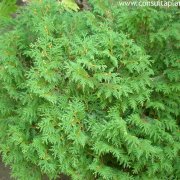Care of the tree Thuja occidentalis or Northern white cedar |
|
The genus Thuja, family Cupressaceae, includes 5 species of conifers native to North America and the Far East. The species are: Thuja occidentalis, Thuja plicata, Thuja standishii, Thuja koraiensis and Thuja sutchuenensis. Common names: Northern white cedar, Eastern white cedar, Arborvitae, American Arbor-Vitae or Siberian Arborvitae. This species is native to Canada and nothern USA. They are evergreen trees with a narrow pyramidal bearing that reach 20 meters (65.6 feet) in height. The leaves are scale-shaped, deep green in color, and produce a pungent odor; there are numerous varieties of other colors. The elongated fruits are light brown in color and measure up to 0.8 cm (0.31") in length. This slow-growing plant is used as isolated specimens and to form hedges. Northern white cedar resists pollution from cities very well. Thuja occidentalis prefers full sun exposure but can also grow in semi-shade. It resists frost well. The soil can be normal garden soil with coarse sand and abundant organic matter. Water regularly so that the substrate never dries out completely and always stays moist. Siberian Arborvitae does not resist drought. Fertilize with compost or manure in the fall. Arborvitae can be lightly pruned in late winter to keep it compact. If Thuja occidentalis suffers drought, it's attacked by aphids but it does not usually present serious pest and disease problems. Eastern white cedar is propagated from seeds sown in late winter in a sandy substrate and by cuttings in summer. |
Images of the tree Thuja occidentalis or Northern white cedar |
Find plants
Thuja occidentalis or Northern white cedar | Care and Growing
© 2025 FavThemes


